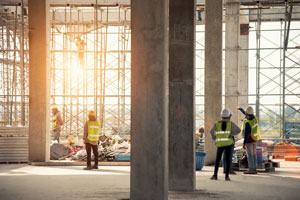Home »
Blog »
Temporary Heating Safety Basics for Your Construction Site
Temporary Heating Safety Basics for Your Construction Site

Construction deadlines don’t stretch when cold weather hits (if they did, we wouldn’t get anything built here in Buffalo and Rochester!) – which means you need to make arrangements to deal with dropping temperatures if you want to keep your construction project on time and on budget.
That’s where temporary propane heating for construction sites comes in.
The problem is that setting up temporary heating can be pretty complicated – especially when it comes to the logistics of temporary heating safety. Here are just some of the safety considerations when setting up a temporary heating site in New York State:
- General OSHA requirements – OSHA (the U.S. Occupational Safety and Hazard Administration) requires employers to provide safe working conditions – which includes providing heated areas for employees to warm up from the cold. OSHA also has regulations regarding temporary heating devices.
- Heater safety requirements – Clean-burning, efficient propane heaters are often used to create warm areas at a worksite. Some notes on propane heater safety:
- The size of propane heaters you need will be determined by conditions on the job (how cold it is, the size of the physical space, how well insulated it is, etc.)
- The area where the propane heater will be used must be properly ventilated per OSHA standards to prevent carbon monoxide build up; carbon monoxide poisoning is a serious health risk that can cause illness or death.
- Propane heaters should always be kept on level surfaces, preferably on concrete or a noncombustible surface. Heaters should never be kept on wood flooring.
- All propane heaters must be kept away from combustible materials (paints, thinners, tarps, tents, stored clothing, etc.) and must have a 100 percent safety shut-off valve.
- Propane heaters must be properly maintained. The Propane Education and Research Council (PERC) offers suggestions for proper treatment of propane heating equipment.
- Tanks that hold more than 100 pounds of propane should never be used indoors, and no more than three 100-pound cylinders should be connected to one manifold.
As you can see, there are many considerations when it comes to setting up safe temporary heating for your construction project – and that doesn’t begin to touch on the logistics of setting up a system to provide ongoing propane refills.
If you need a temporary heating solution for your next project, call on the experts at Irish Propane. Whether you need a temporary heating system to dry paint, run equipment or simply to stay warm, we will get the job done right, and done safely.
Need temporary heating at your construction site? Trust the pros at Irish Propane. Contact us today to learn more about the many ways we can support your project – we are happy to provide you with a FREE, no obligation estimate on a temporary heating solution!

